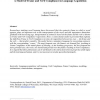Free Online Productivity Tools
i2Speak
i2Symbol
i2OCR
iTex2Img
iWeb2Print
iWeb2Shot
i2Type
iPdf2Split
iPdf2Merge
i2Bopomofo
i2Arabic
i2Style
i2Image
i2PDF
iLatex2Rtf
Sci2ools
95
Voted
IJON
2007
2007
A model of Frame and Verb Compliance in language acquisition
Researchers studying word learning have discovered that the syntactic frame in which a word appears plays an important role in the interpretation of the word, and this importance diminishes gradually with increasing age. Interpretation of sentences based on the frame and the verb is known as Frame and Verb Compliance respectively. Here, a connectionist model is presented that explains the shift from Frame to Verb Compliance in terms of competition between two cues — the frame and the verb — that predict causality. The model learns a miniature language by associating sentences with the corresponding “scenes.” The most frequent cues, the frames, are learned first, resulting in Frame Compliance in the initial phase of learning. As the learning progresses, the less frequent but more powerful cues, the verbs, are learned and prevail over the frames resulting in Verb Compliance. It is argued that these phenomena can be attributed to the interaction between properties of the input an...
Related Content
| Added | 15 Dec 2010 |
| Updated | 15 Dec 2010 |
| Type | Journal |
| Year | 2007 |
| Where | IJON |
| Authors | Rutvik Desai |
Comments (0)

